University Organisational Development Assignment - Leadership Module
VerifiedAdded on 2022/09/01
|9
|2025
|24
Homework Assignment
AI Summary
This assignment solution delves into the core aspects of organisational development, exploring how to diagnose and manage organisational culture to prepare for transformation. It addresses change management, leadership, and strategies for overcoming resistance. The solution examines key characteristics of the hospitality industry, outlining technology trends, emotional promotion, and exclusivity. It also covers restructuring, including mergers, acquisitions, legal changes, turnarounds, divestment, and spin-offs. The assignment differentiates between planned and unplanned change, providing strategies to manage resistance and implement change effectively. It further explores organisational learning and knowledge management, highlighting their distinctions and interconnectedness. The solution also suggests gamification as an innovative method to implement change and reduce resistance, along with additional strategies for committed leadership in managing change. References are included to support the arguments and findings.
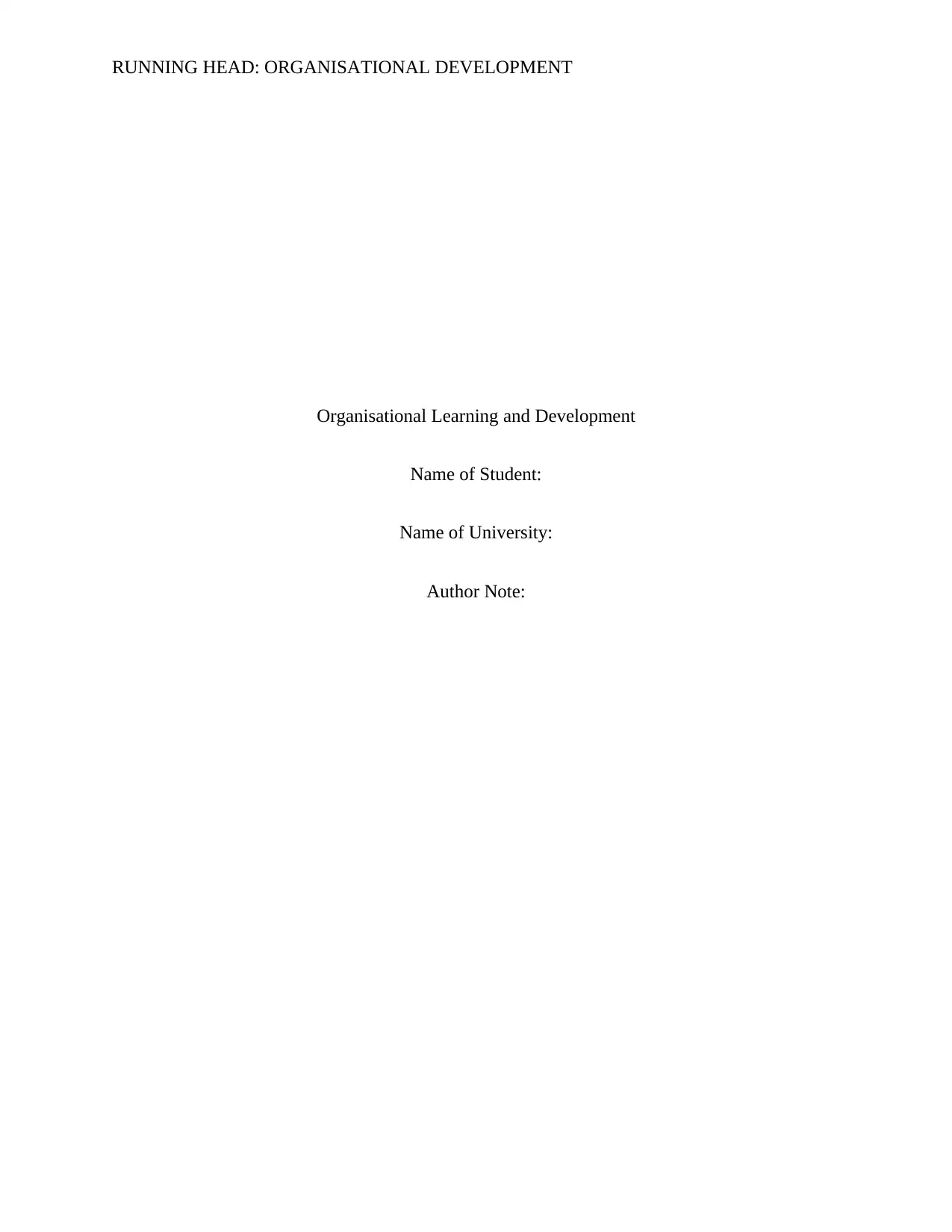
RUNNING HEAD: ORGANISATIONAL DEVELOPMENT
Organisational Learning and Development
Name of Student:
Name of University:
Author Note:
Organisational Learning and Development
Name of Student:
Name of University:
Author Note:
Paraphrase This Document
Need a fresh take? Get an instant paraphrase of this document with our AI Paraphraser
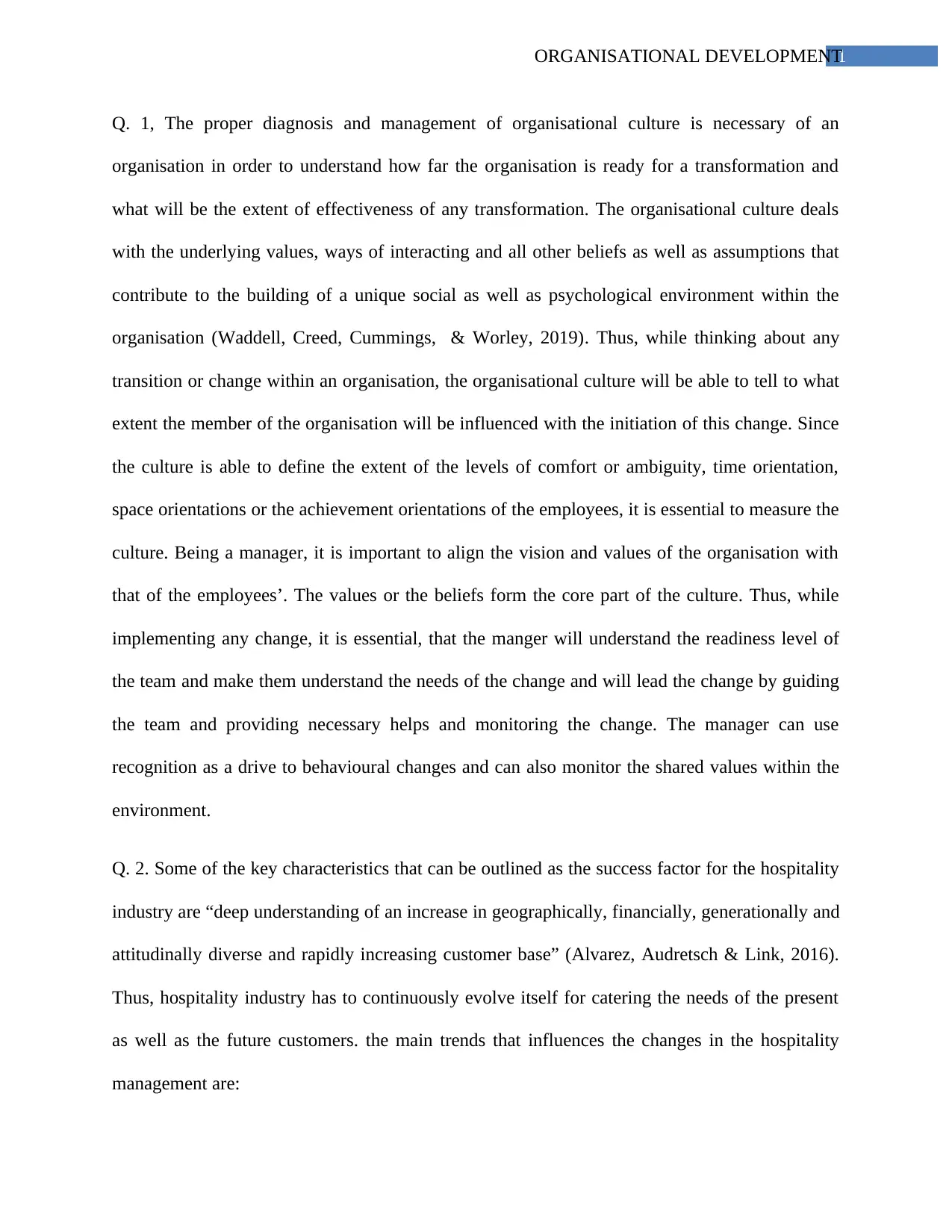
1ORGANISATIONAL DEVELOPMENT
Q. 1, The proper diagnosis and management of organisational culture is necessary of an
organisation in order to understand how far the organisation is ready for a transformation and
what will be the extent of effectiveness of any transformation. The organisational culture deals
with the underlying values, ways of interacting and all other beliefs as well as assumptions that
contribute to the building of a unique social as well as psychological environment within the
organisation (Waddell, Creed, Cummings, & Worley, 2019). Thus, while thinking about any
transition or change within an organisation, the organisational culture will be able to tell to what
extent the member of the organisation will be influenced with the initiation of this change. Since
the culture is able to define the extent of the levels of comfort or ambiguity, time orientation,
space orientations or the achievement orientations of the employees, it is essential to measure the
culture. Being a manager, it is important to align the vision and values of the organisation with
that of the employees’. The values or the beliefs form the core part of the culture. Thus, while
implementing any change, it is essential, that the manger will understand the readiness level of
the team and make them understand the needs of the change and will lead the change by guiding
the team and providing necessary helps and monitoring the change. The manager can use
recognition as a drive to behavioural changes and can also monitor the shared values within the
environment.
Q. 2. Some of the key characteristics that can be outlined as the success factor for the hospitality
industry are “deep understanding of an increase in geographically, financially, generationally and
attitudinally diverse and rapidly increasing customer base” (Alvarez, Audretsch & Link, 2016).
Thus, hospitality industry has to continuously evolve itself for catering the needs of the present
as well as the future customers. the main trends that influences the changes in the hospitality
management are:
Q. 1, The proper diagnosis and management of organisational culture is necessary of an
organisation in order to understand how far the organisation is ready for a transformation and
what will be the extent of effectiveness of any transformation. The organisational culture deals
with the underlying values, ways of interacting and all other beliefs as well as assumptions that
contribute to the building of a unique social as well as psychological environment within the
organisation (Waddell, Creed, Cummings, & Worley, 2019). Thus, while thinking about any
transition or change within an organisation, the organisational culture will be able to tell to what
extent the member of the organisation will be influenced with the initiation of this change. Since
the culture is able to define the extent of the levels of comfort or ambiguity, time orientation,
space orientations or the achievement orientations of the employees, it is essential to measure the
culture. Being a manager, it is important to align the vision and values of the organisation with
that of the employees’. The values or the beliefs form the core part of the culture. Thus, while
implementing any change, it is essential, that the manger will understand the readiness level of
the team and make them understand the needs of the change and will lead the change by guiding
the team and providing necessary helps and monitoring the change. The manager can use
recognition as a drive to behavioural changes and can also monitor the shared values within the
environment.
Q. 2. Some of the key characteristics that can be outlined as the success factor for the hospitality
industry are “deep understanding of an increase in geographically, financially, generationally and
attitudinally diverse and rapidly increasing customer base” (Alvarez, Audretsch & Link, 2016).
Thus, hospitality industry has to continuously evolve itself for catering the needs of the present
as well as the future customers. the main trends that influences the changes in the hospitality
management are:
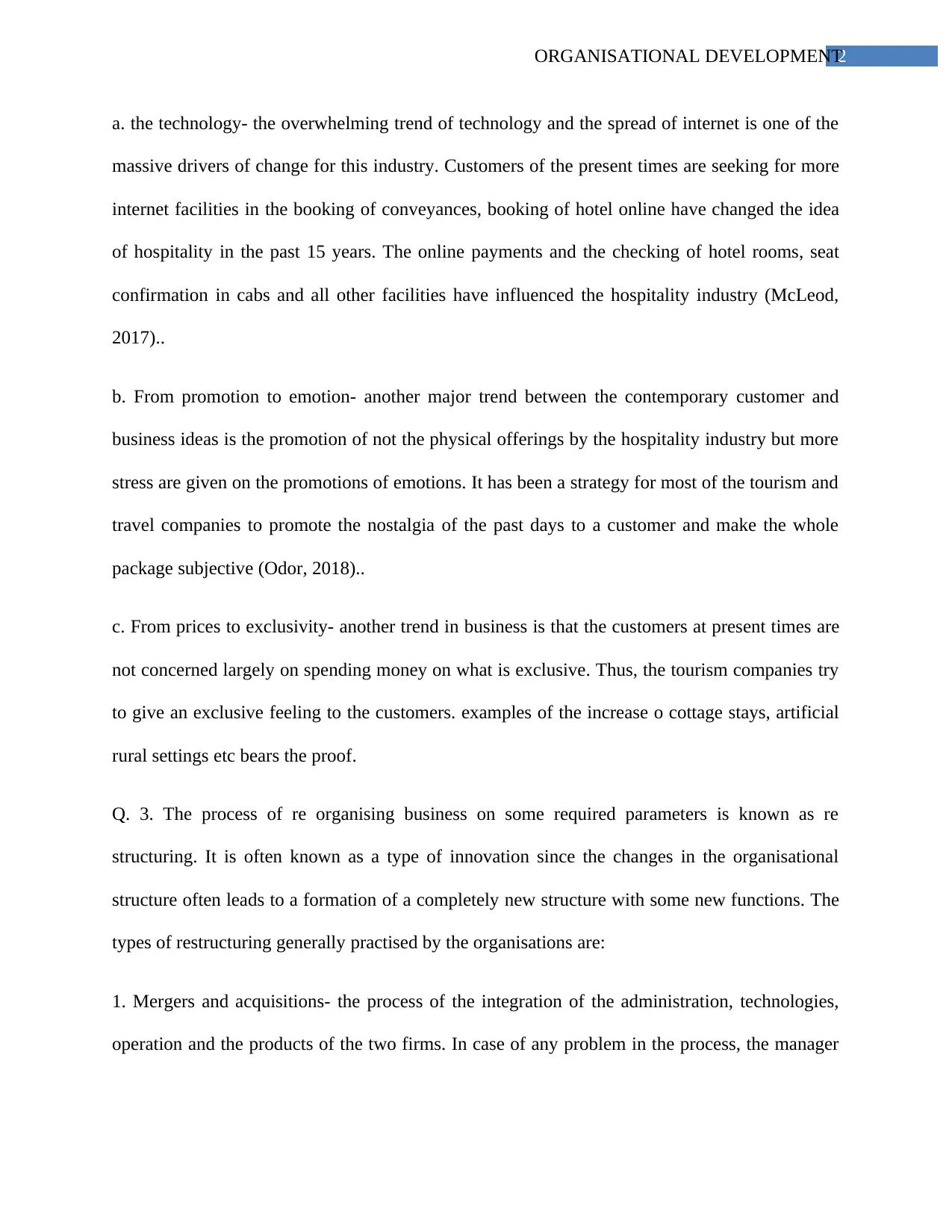
2ORGANISATIONAL DEVELOPMENT
a. the technology- the overwhelming trend of technology and the spread of internet is one of the
massive drivers of change for this industry. Customers of the present times are seeking for more
internet facilities in the booking of conveyances, booking of hotel online have changed the idea
of hospitality in the past 15 years. The online payments and the checking of hotel rooms, seat
confirmation in cabs and all other facilities have influenced the hospitality industry (McLeod,
2017)..
b. From promotion to emotion- another major trend between the contemporary customer and
business ideas is the promotion of not the physical offerings by the hospitality industry but more
stress are given on the promotions of emotions. It has been a strategy for most of the tourism and
travel companies to promote the nostalgia of the past days to a customer and make the whole
package subjective (Odor, 2018)..
c. From prices to exclusivity- another trend in business is that the customers at present times are
not concerned largely on spending money on what is exclusive. Thus, the tourism companies try
to give an exclusive feeling to the customers. examples of the increase o cottage stays, artificial
rural settings etc bears the proof.
Q. 3. The process of re organising business on some required parameters is known as re
structuring. It is often known as a type of innovation since the changes in the organisational
structure often leads to a formation of a completely new structure with some new functions. The
types of restructuring generally practised by the organisations are:
1. Mergers and acquisitions- the process of the integration of the administration, technologies,
operation and the products of the two firms. In case of any problem in the process, the manager
a. the technology- the overwhelming trend of technology and the spread of internet is one of the
massive drivers of change for this industry. Customers of the present times are seeking for more
internet facilities in the booking of conveyances, booking of hotel online have changed the idea
of hospitality in the past 15 years. The online payments and the checking of hotel rooms, seat
confirmation in cabs and all other facilities have influenced the hospitality industry (McLeod,
2017)..
b. From promotion to emotion- another major trend between the contemporary customer and
business ideas is the promotion of not the physical offerings by the hospitality industry but more
stress are given on the promotions of emotions. It has been a strategy for most of the tourism and
travel companies to promote the nostalgia of the past days to a customer and make the whole
package subjective (Odor, 2018)..
c. From prices to exclusivity- another trend in business is that the customers at present times are
not concerned largely on spending money on what is exclusive. Thus, the tourism companies try
to give an exclusive feeling to the customers. examples of the increase o cottage stays, artificial
rural settings etc bears the proof.
Q. 3. The process of re organising business on some required parameters is known as re
structuring. It is often known as a type of innovation since the changes in the organisational
structure often leads to a formation of a completely new structure with some new functions. The
types of restructuring generally practised by the organisations are:
1. Mergers and acquisitions- the process of the integration of the administration, technologies,
operation and the products of the two firms. In case of any problem in the process, the manager
⊘ This is a preview!⊘
Do you want full access?
Subscribe today to unlock all pages.

Trusted by 1+ million students worldwide
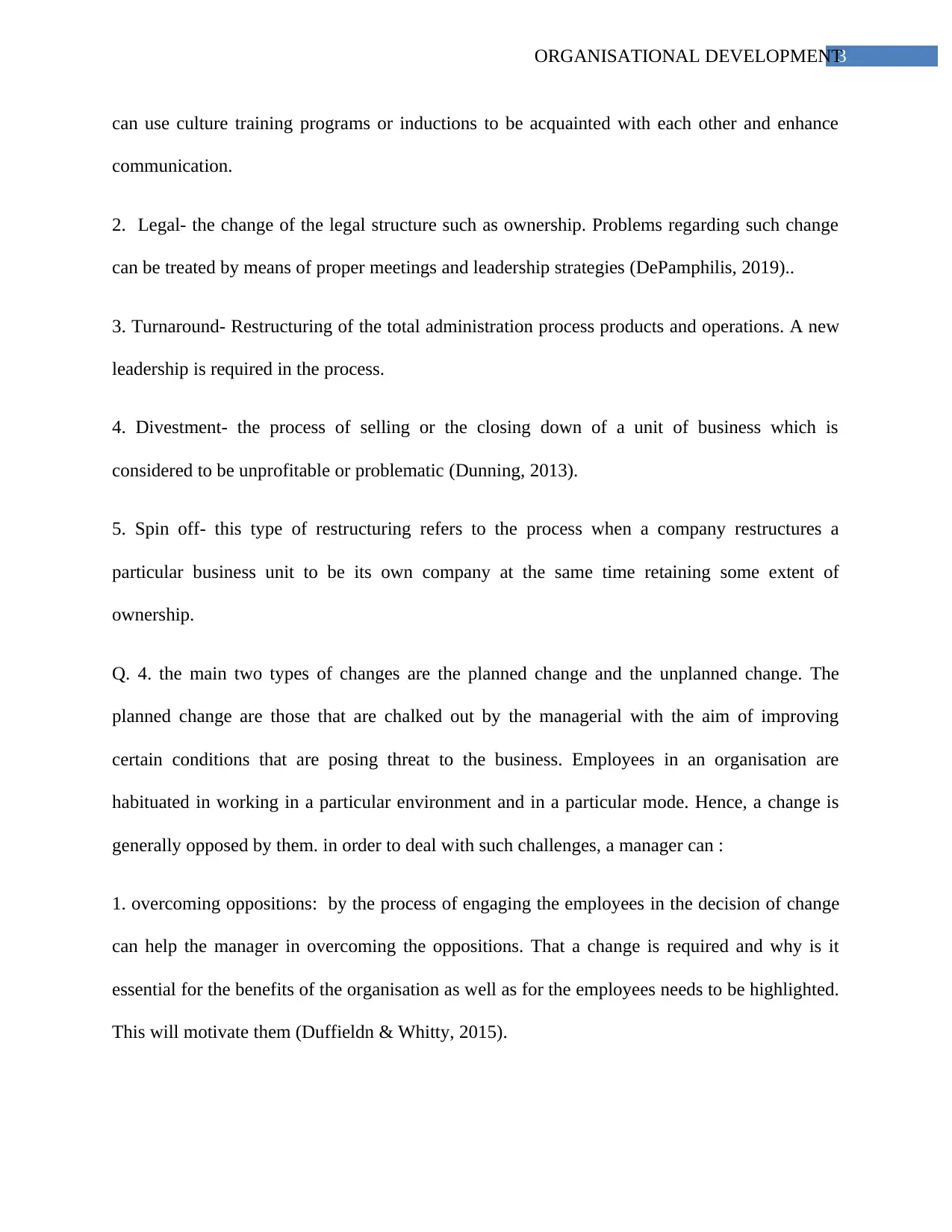
3ORGANISATIONAL DEVELOPMENT
can use culture training programs or inductions to be acquainted with each other and enhance
communication.
2. Legal- the change of the legal structure such as ownership. Problems regarding such change
can be treated by means of proper meetings and leadership strategies (DePamphilis, 2019)..
3. Turnaround- Restructuring of the total administration process products and operations. A new
leadership is required in the process.
4. Divestment- the process of selling or the closing down of a unit of business which is
considered to be unprofitable or problematic (Dunning, 2013).
5. Spin off- this type of restructuring refers to the process when a company restructures a
particular business unit to be its own company at the same time retaining some extent of
ownership.
Q. 4. the main two types of changes are the planned change and the unplanned change. The
planned change are those that are chalked out by the managerial with the aim of improving
certain conditions that are posing threat to the business. Employees in an organisation are
habituated in working in a particular environment and in a particular mode. Hence, a change is
generally opposed by them. in order to deal with such challenges, a manager can :
1. overcoming oppositions: by the process of engaging the employees in the decision of change
can help the manager in overcoming the oppositions. That a change is required and why is it
essential for the benefits of the organisation as well as for the employees needs to be highlighted.
This will motivate them (Duffieldn & Whitty, 2015).
can use culture training programs or inductions to be acquainted with each other and enhance
communication.
2. Legal- the change of the legal structure such as ownership. Problems regarding such change
can be treated by means of proper meetings and leadership strategies (DePamphilis, 2019)..
3. Turnaround- Restructuring of the total administration process products and operations. A new
leadership is required in the process.
4. Divestment- the process of selling or the closing down of a unit of business which is
considered to be unprofitable or problematic (Dunning, 2013).
5. Spin off- this type of restructuring refers to the process when a company restructures a
particular business unit to be its own company at the same time retaining some extent of
ownership.
Q. 4. the main two types of changes are the planned change and the unplanned change. The
planned change are those that are chalked out by the managerial with the aim of improving
certain conditions that are posing threat to the business. Employees in an organisation are
habituated in working in a particular environment and in a particular mode. Hence, a change is
generally opposed by them. in order to deal with such challenges, a manager can :
1. overcoming oppositions: by the process of engaging the employees in the decision of change
can help the manager in overcoming the oppositions. That a change is required and why is it
essential for the benefits of the organisation as well as for the employees needs to be highlighted.
This will motivate them (Duffieldn & Whitty, 2015).
Paraphrase This Document
Need a fresh take? Get an instant paraphrase of this document with our AI Paraphraser
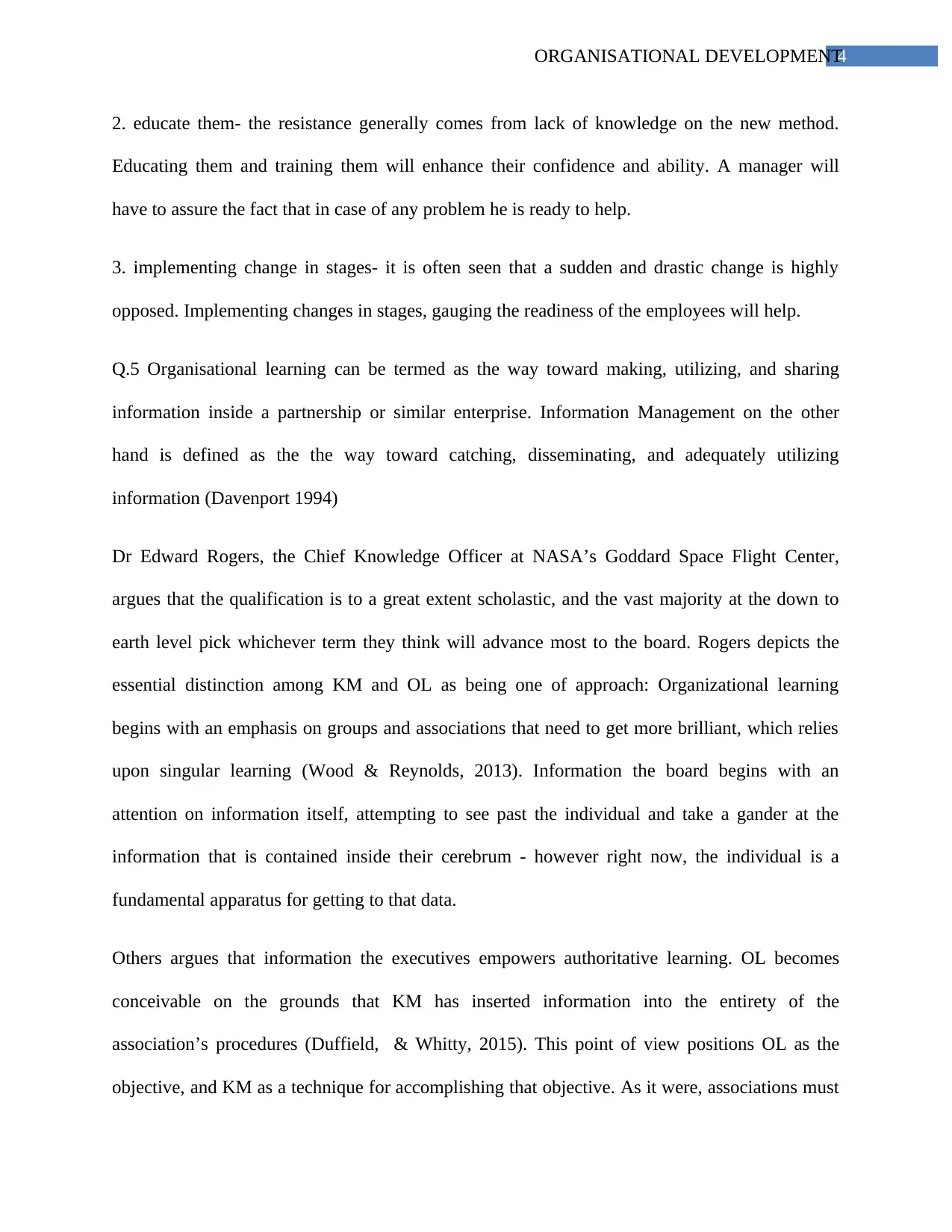
4ORGANISATIONAL DEVELOPMENT
2. educate them- the resistance generally comes from lack of knowledge on the new method.
Educating them and training them will enhance their confidence and ability. A manager will
have to assure the fact that in case of any problem he is ready to help.
3. implementing change in stages- it is often seen that a sudden and drastic change is highly
opposed. Implementing changes in stages, gauging the readiness of the employees will help.
Q.5 Organisational learning can be termed as the way toward making, utilizing, and sharing
information inside a partnership or similar enterprise. Information Management on the other
hand is defined as the the way toward catching, disseminating, and adequately utilizing
information (Davenport 1994)
Dr Edward Rogers, the Chief Knowledge Officer at NASA’s Goddard Space Flight Center,
argues that the qualification is to a great extent scholastic, and the vast majority at the down to
earth level pick whichever term they think will advance most to the board. Rogers depicts the
essential distinction among KM and OL as being one of approach: Organizational learning
begins with an emphasis on groups and associations that need to get more brilliant, which relies
upon singular learning (Wood & Reynolds, 2013). Information the board begins with an
attention on information itself, attempting to see past the individual and take a gander at the
information that is contained inside their cerebrum - however right now, the individual is a
fundamental apparatus for getting to that data.
Others argues that information the executives empowers authoritative learning. OL becomes
conceivable on the grounds that KM has inserted information into the entirety of the
association’s procedures (Duffield, & Whitty, 2015). This point of view positions OL as the
objective, and KM as a technique for accomplishing that objective. As it were, associations must
2. educate them- the resistance generally comes from lack of knowledge on the new method.
Educating them and training them will enhance their confidence and ability. A manager will
have to assure the fact that in case of any problem he is ready to help.
3. implementing change in stages- it is often seen that a sudden and drastic change is highly
opposed. Implementing changes in stages, gauging the readiness of the employees will help.
Q.5 Organisational learning can be termed as the way toward making, utilizing, and sharing
information inside a partnership or similar enterprise. Information Management on the other
hand is defined as the the way toward catching, disseminating, and adequately utilizing
information (Davenport 1994)
Dr Edward Rogers, the Chief Knowledge Officer at NASA’s Goddard Space Flight Center,
argues that the qualification is to a great extent scholastic, and the vast majority at the down to
earth level pick whichever term they think will advance most to the board. Rogers depicts the
essential distinction among KM and OL as being one of approach: Organizational learning
begins with an emphasis on groups and associations that need to get more brilliant, which relies
upon singular learning (Wood & Reynolds, 2013). Information the board begins with an
attention on information itself, attempting to see past the individual and take a gander at the
information that is contained inside their cerebrum - however right now, the individual is a
fundamental apparatus for getting to that data.
Others argues that information the executives empowers authoritative learning. OL becomes
conceivable on the grounds that KM has inserted information into the entirety of the
association’s procedures (Duffield, & Whitty, 2015). This point of view positions OL as the
objective, and KM as a technique for accomplishing that objective. As it were, associations must
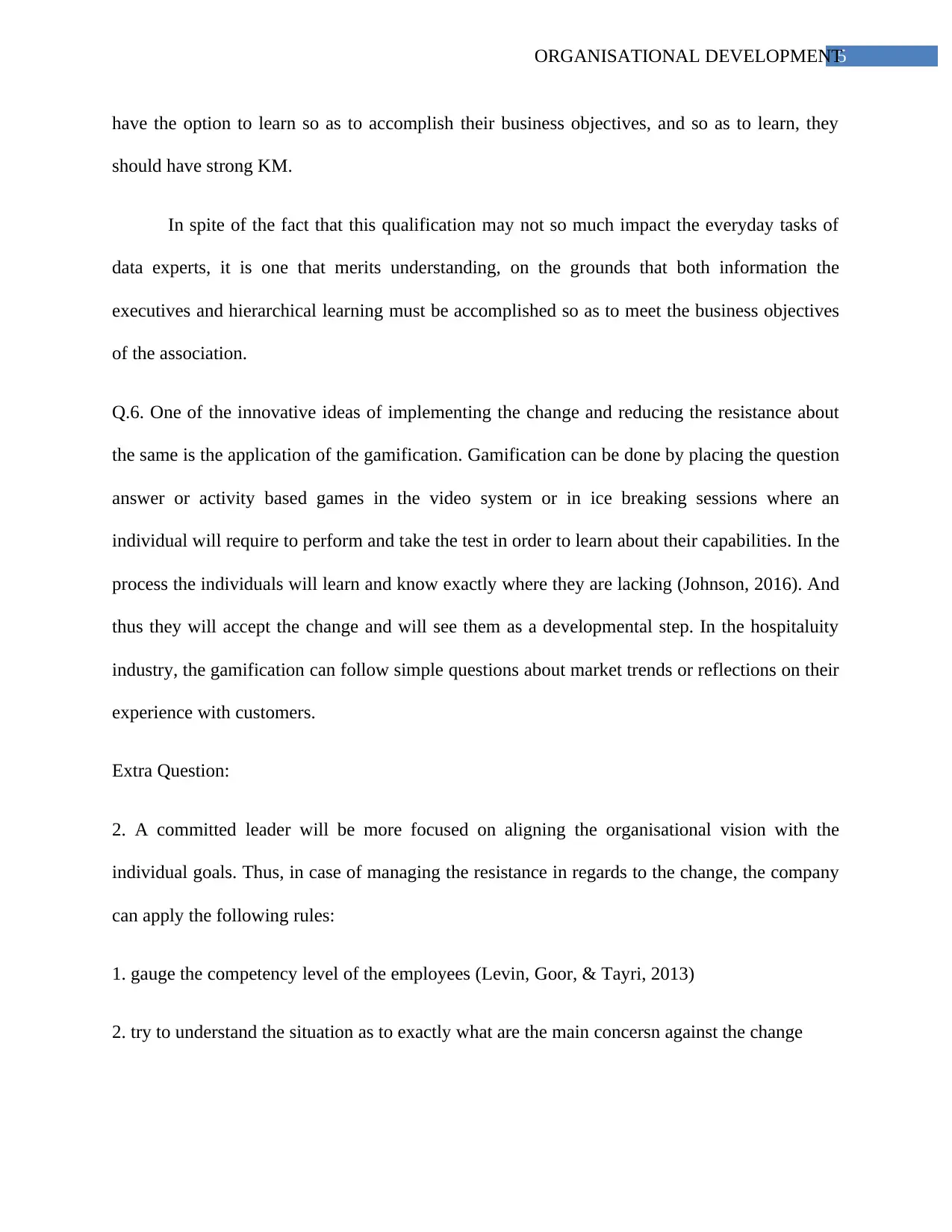
5ORGANISATIONAL DEVELOPMENT
have the option to learn so as to accomplish their business objectives, and so as to learn, they
should have strong KM.
In spite of the fact that this qualification may not so much impact the everyday tasks of
data experts, it is one that merits understanding, on the grounds that both information the
executives and hierarchical learning must be accomplished so as to meet the business objectives
of the association.
Q.6. One of the innovative ideas of implementing the change and reducing the resistance about
the same is the application of the gamification. Gamification can be done by placing the question
answer or activity based games in the video system or in ice breaking sessions where an
individual will require to perform and take the test in order to learn about their capabilities. In the
process the individuals will learn and know exactly where they are lacking (Johnson, 2016). And
thus they will accept the change and will see them as a developmental step. In the hospitaluity
industry, the gamification can follow simple questions about market trends or reflections on their
experience with customers.
Extra Question:
2. A committed leader will be more focused on aligning the organisational vision with the
individual goals. Thus, in case of managing the resistance in regards to the change, the company
can apply the following rules:
1. gauge the competency level of the employees (Levin, Goor, & Tayri, 2013)
2. try to understand the situation as to exactly what are the main concersn against the change
have the option to learn so as to accomplish their business objectives, and so as to learn, they
should have strong KM.
In spite of the fact that this qualification may not so much impact the everyday tasks of
data experts, it is one that merits understanding, on the grounds that both information the
executives and hierarchical learning must be accomplished so as to meet the business objectives
of the association.
Q.6. One of the innovative ideas of implementing the change and reducing the resistance about
the same is the application of the gamification. Gamification can be done by placing the question
answer or activity based games in the video system or in ice breaking sessions where an
individual will require to perform and take the test in order to learn about their capabilities. In the
process the individuals will learn and know exactly where they are lacking (Johnson, 2016). And
thus they will accept the change and will see them as a developmental step. In the hospitaluity
industry, the gamification can follow simple questions about market trends or reflections on their
experience with customers.
Extra Question:
2. A committed leader will be more focused on aligning the organisational vision with the
individual goals. Thus, in case of managing the resistance in regards to the change, the company
can apply the following rules:
1. gauge the competency level of the employees (Levin, Goor, & Tayri, 2013)
2. try to understand the situation as to exactly what are the main concersn against the change
⊘ This is a preview!⊘
Do you want full access?
Subscribe today to unlock all pages.

Trusted by 1+ million students worldwide
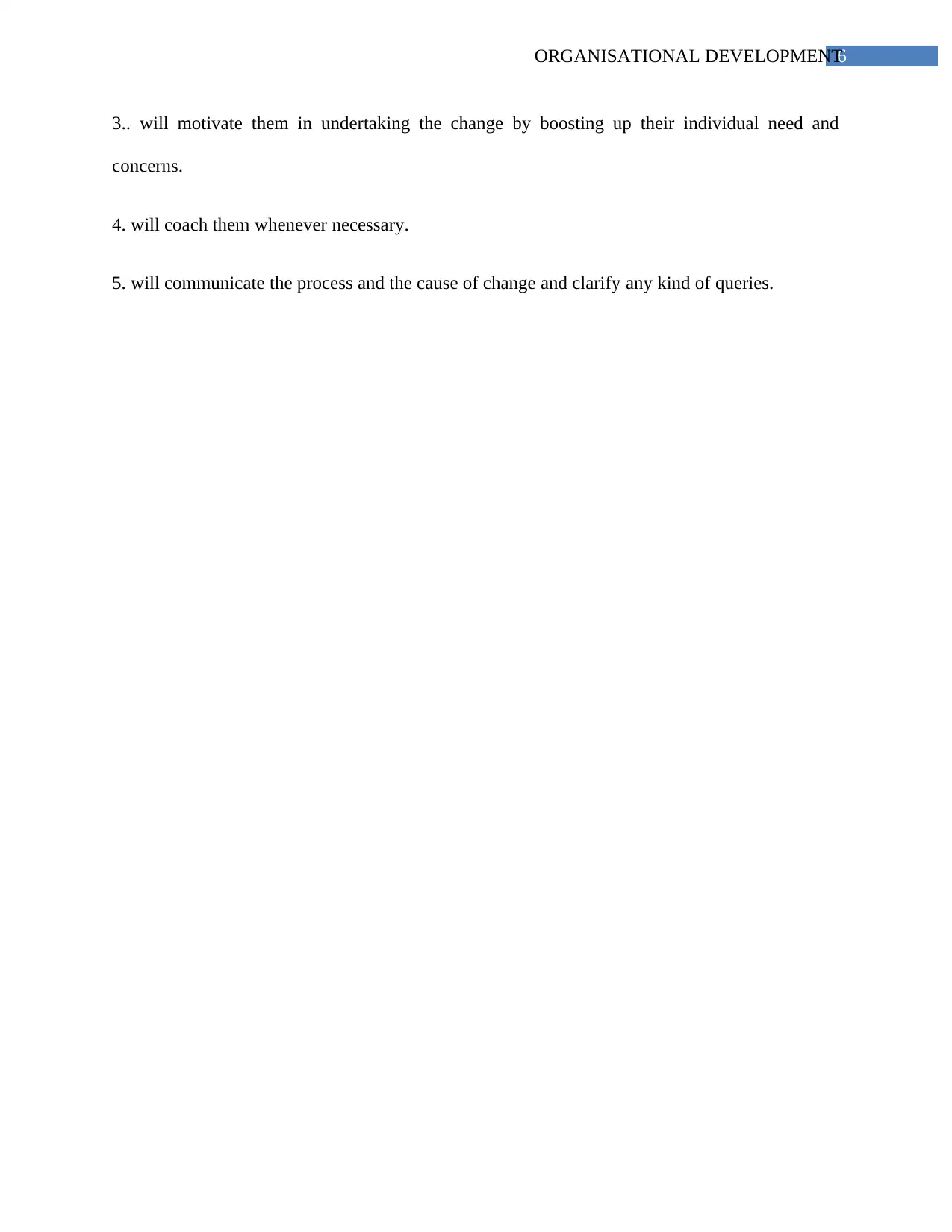
6ORGANISATIONAL DEVELOPMENT
3.. will motivate them in undertaking the change by boosting up their individual need and
concerns.
4. will coach them whenever necessary.
5. will communicate the process and the cause of change and clarify any kind of queries.
3.. will motivate them in undertaking the change by boosting up their individual need and
concerns.
4. will coach them whenever necessary.
5. will communicate the process and the cause of change and clarify any kind of queries.
Paraphrase This Document
Need a fresh take? Get an instant paraphrase of this document with our AI Paraphraser
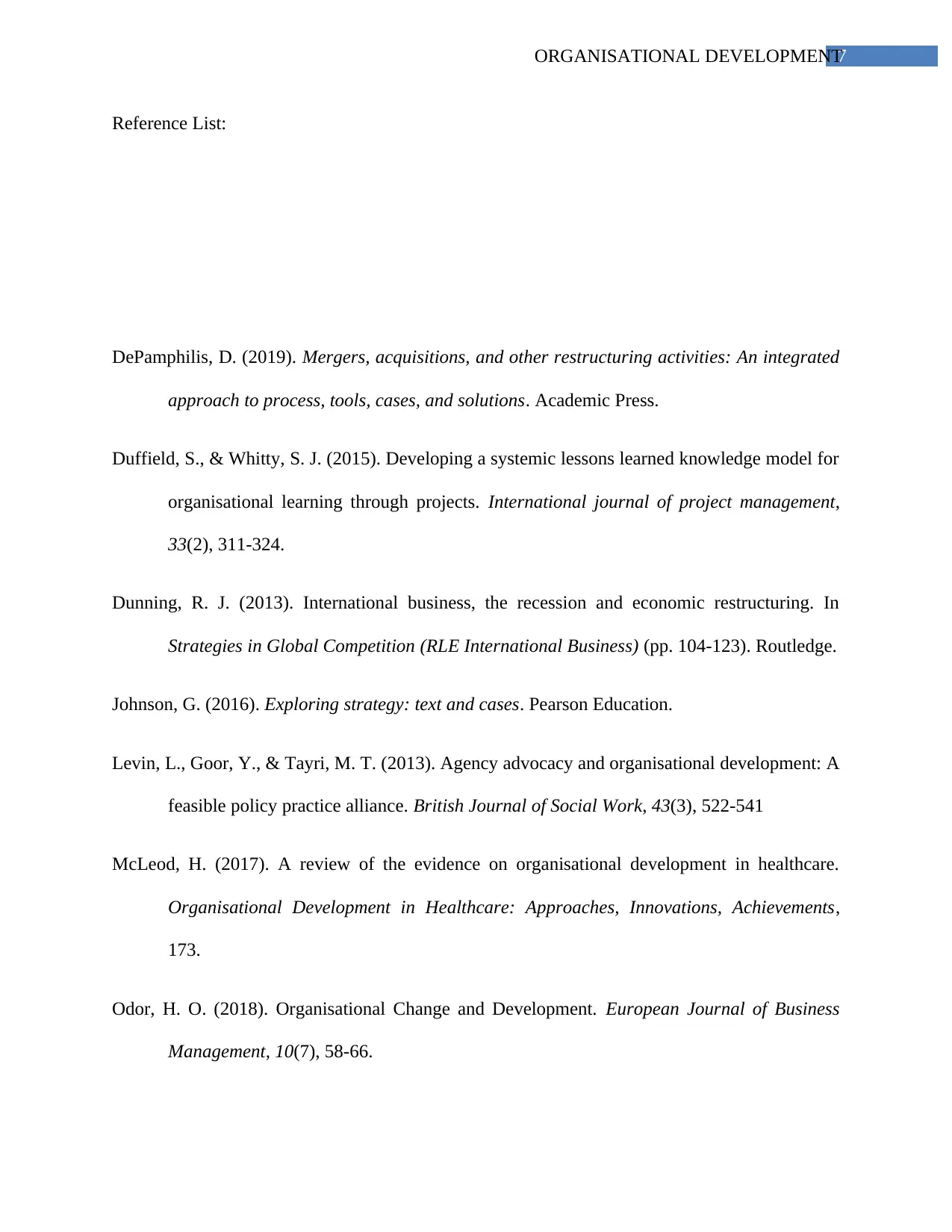
7ORGANISATIONAL DEVELOPMENT
Reference List:
DePamphilis, D. (2019). Mergers, acquisitions, and other restructuring activities: An integrated
approach to process, tools, cases, and solutions. Academic Press.
Duffield, S., & Whitty, S. J. (2015). Developing a systemic lessons learned knowledge model for
organisational learning through projects. International journal of project management,
33(2), 311-324.
Dunning, R. J. (2013). International business, the recession and economic restructuring. In
Strategies in Global Competition (RLE International Business) (pp. 104-123). Routledge.
Johnson, G. (2016). Exploring strategy: text and cases. Pearson Education.
Levin, L., Goor, Y., & Tayri, M. T. (2013). Agency advocacy and organisational development: A
feasible policy practice alliance. British Journal of Social Work, 43(3), 522-541
McLeod, H. (2017). A review of the evidence on organisational development in healthcare.
Organisational Development in Healthcare: Approaches, Innovations, Achievements,
173.
Odor, H. O. (2018). Organisational Change and Development. European Journal of Business
Management, 10(7), 58-66.
Reference List:
DePamphilis, D. (2019). Mergers, acquisitions, and other restructuring activities: An integrated
approach to process, tools, cases, and solutions. Academic Press.
Duffield, S., & Whitty, S. J. (2015). Developing a systemic lessons learned knowledge model for
organisational learning through projects. International journal of project management,
33(2), 311-324.
Dunning, R. J. (2013). International business, the recession and economic restructuring. In
Strategies in Global Competition (RLE International Business) (pp. 104-123). Routledge.
Johnson, G. (2016). Exploring strategy: text and cases. Pearson Education.
Levin, L., Goor, Y., & Tayri, M. T. (2013). Agency advocacy and organisational development: A
feasible policy practice alliance. British Journal of Social Work, 43(3), 522-541
McLeod, H. (2017). A review of the evidence on organisational development in healthcare.
Organisational Development in Healthcare: Approaches, Innovations, Achievements,
173.
Odor, H. O. (2018). Organisational Change and Development. European Journal of Business
Management, 10(7), 58-66.
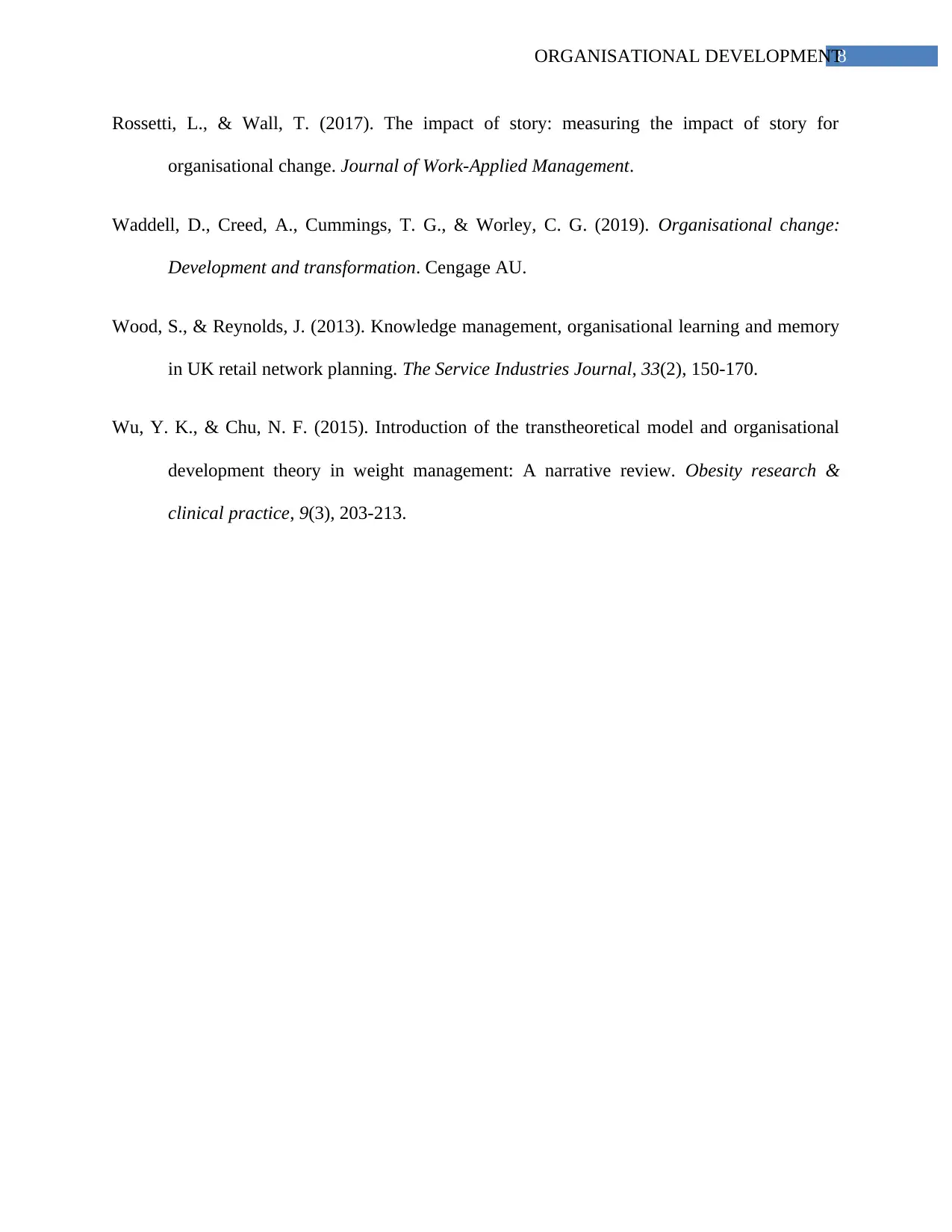
8ORGANISATIONAL DEVELOPMENT
Rossetti, L., & Wall, T. (2017). The impact of story: measuring the impact of story for
organisational change. Journal of Work-Applied Management.
Waddell, D., Creed, A., Cummings, T. G., & Worley, C. G. (2019). Organisational change:
Development and transformation. Cengage AU.
Wood, S., & Reynolds, J. (2013). Knowledge management, organisational learning and memory
in UK retail network planning. The Service Industries Journal, 33(2), 150-170.
Wu, Y. K., & Chu, N. F. (2015). Introduction of the transtheoretical model and organisational
development theory in weight management: A narrative review. Obesity research &
clinical practice, 9(3), 203-213.
Rossetti, L., & Wall, T. (2017). The impact of story: measuring the impact of story for
organisational change. Journal of Work-Applied Management.
Waddell, D., Creed, A., Cummings, T. G., & Worley, C. G. (2019). Organisational change:
Development and transformation. Cengage AU.
Wood, S., & Reynolds, J. (2013). Knowledge management, organisational learning and memory
in UK retail network planning. The Service Industries Journal, 33(2), 150-170.
Wu, Y. K., & Chu, N. F. (2015). Introduction of the transtheoretical model and organisational
development theory in weight management: A narrative review. Obesity research &
clinical practice, 9(3), 203-213.
⊘ This is a preview!⊘
Do you want full access?
Subscribe today to unlock all pages.

Trusted by 1+ million students worldwide
1 out of 9
Related Documents
Your All-in-One AI-Powered Toolkit for Academic Success.
+13062052269
info@desklib.com
Available 24*7 on WhatsApp / Email
![[object Object]](/_next/static/media/star-bottom.7253800d.svg)
Unlock your academic potential
Copyright © 2020–2025 A2Z Services. All Rights Reserved. Developed and managed by ZUCOL.





